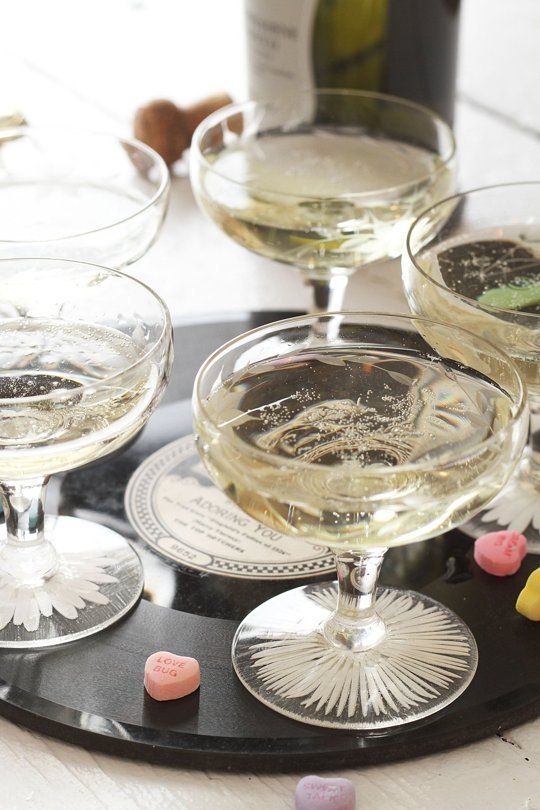We recently posted Our Favorite Unique Ways to Serve Champagne on our Global Gourmet Weddings Blog. We thought we’d follow up here with some very interesting facts (we think so anyway) about the champagne glass itself and its complex evolution. From vintage sophistication to modern practicality, take a quick journey through the science and design behind the stemware that has come to represent so much more than just a way of drinking bubbly.
1. The Coupe Glass

It’s been said that the round and broad design of the vintage coupe champagne glass, which has been around almost as long as champagne itself, was originally molded from Marie Antoinette’s left breast. She commissioned this so her court could toast to her health. This legend is both true and false. The truth is that the coupe champagne glass came about long before the reign of the French queen, so it was definitely not molded from her anatomy. However, she did have porcelain bowls molded from her chest that were designed for her and her ladies-in-waiting to drink milk out of.
Despite being around for hundreds of years, the vintage coupe glass became all the rage in the United States in the post-prohibition era of the 1930’s. It fell out of fashion in the 1960’s when the sweeter champagnes of yesteryear were being made increasingly more dry. The wide surface area of the coupe glass tended to make dryer champagnes go flat rather quickly. This led to the coupe glass’ downfall and the rise of the champagne flute. The coupe glass is no longer a popular choice for drinking champagne but rather a symbol of vintage sophistication from a bygone era.
2. The Champagne Flute

From the first emergence of the champagne flute, it has been seen as an icon of luxury and class. This glass has been designed and redesigned more than any other form of glassware and was originally created to compensate for the shortfalls of the coupe glass. The science behind it is that a rough bead at the base of the glass allows the bubbles, which capture and deliver flavor and aroma, to gather and then quickly rise to the top. This not only creates more taste than the coupe glass, but is also visually more impressive. However, there is a downside to the flute. Aromas can be lost due to the small amount of air space at the top of the glass. The flute’s main function is to retain carbonation, but it falls flat in terms of collecting and developing aromas and flavor to their utmost potential.
3. The Tulip Glass

Not as well-known or as widely used as the coupe or flute glasses, the tulip glass has the long stem and slim base of the flute but opens up to a widening bowl shape in the middle and then narrows slightly at the top. Due to this widening and sliming frame, the tulip glass takes its name from the flower whose shape it closely resembles. This structure is like the flute in that it maintains carbonation, but with the wider aperture, more aeration is allowed which helps in developing the flavors and aromas, thus making it a more practical, although less iconic, glass to use.
4. The Wine Glass

Many experts now say you should ditch the traditional champagne glass altogether and opt for a white wine glass instead to enjoy your bubbly. The belling out of the wine glass lets the champagne’s aromas develop in contact with the air while a taper at the mouth holds the majority of the carbonation in. You will get a stronger, more aromatic and flavorful champagne experience with the wine glass which is slowly starting to take over as the preferred stemware for champagne enthusiasts.
With all that being said, how will you enjoy your next glass of bubbly?
Archives
Select Month
